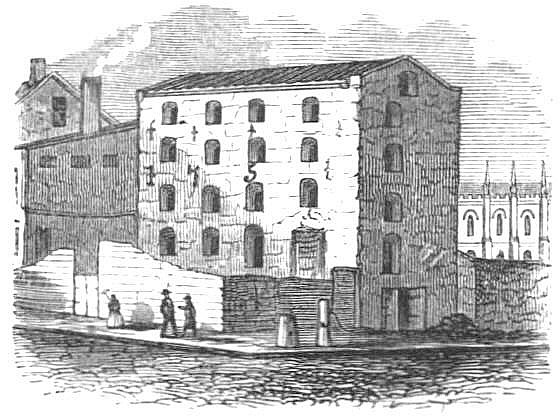
PICTORIAL FIELD BOOK OF THE REVOLUTION.
VOLUME II.
BY BENSON J. LOSSING
1850.
------------------------------------------------------------------------
SUPPLEMENT.
IV.
BRITISH PRISONS AND PRISON SHIPS.
------------------------------------------------------------------------
Associations of intense horror are linked with the memory and the records of the cruelties practiced and sufferings endured in the prisons and prison ships at New York, in which thousands of captive patriots were from time to time incarcerated during the war for Independence. Those who were made prisoners on land were confined in the foul jails of the city, while captive seamen, and sometimes soldiers too, were kept for months in floating dungeons,
"-----
doomed to famine, shackles, and despair,
Condemned to breathe a foul, infected air
In sickly hulks, devoted while they lay –
Successive funerals gloomed each dismal day."
We have before observed that the prisoners taken in the battle near Brooklyn in August, and at Fort Washington in November, 1776, 2 almost four thousand in all, were confined in prisons in the city of New York. Probably more than a thousand private citizens, arrested by the British on suspicion or positive proof of their being active Whigs, were also made prisoners, and at the close of the year, at least five thousand American captives were in the power of the invaders. The only prisons proper in the city were the "New Jail" and the "New Bridewell." The former, entirely altered in appearance, is the present Hall of Records in the Park, east of the City Hall; the latter stood between the present City Hall and Broadway. These were quite insufficient, and the three spacious sugar-houses then in the city, some of the Dissenting churches, Columbia College, and the Hospital, were all used as prisons. The disastrous effects of the great fire in September, the demands of the British army for supplies, the indolent indifference of Sir William Howe, and the cruel conduct of Cunningham, the provost marshal, combined to produce intense suffering among the prisoners.

VAN CORTLANDT’S SUGAR HOUSE.
Van Cortlandt’s Sugar-house, which stood at the northwest corner of Trinity church-yard, corner of Thames and Lumber Streets; Rhinelander’s, on the corner of William and Duane Streets, now (1852) Lightbody’s Printing-ink Manufactory; and the more eminently historical one on Liberty Street (numbers 34 and 36), a few feet eastward of the Middle Dutch church, now the Post-office, were the most spacious buildings in the city, and answered the purposes of prisons very well. Rhinelander’s is the only one remaining, the one on Liberty Street having been demolished in June, 1840, and Van Cortlandt’s during the summer of 1852. The North Dutch church, yet standing on William Street, between Fulton and Ann, was made to contain eight hundred prisoners, after taking out the pews and using them for fuel, 3 and placing a floor across from gallery to gallery. For about two months several hundred prisoners were huddled together in the Middle Dutch church (see page 629), when they were removed, and it was converted into a riding-school, after taking out the pews. 4 The "Brick church," yet standing in the triangle between Park Row and Beekman and Nassau Streets, was used for a prison a short time, when it, and the Presbyterian church in Wall Street, the Scotch church in Cedar Street, and the Friend’s Meeting-house in Liberty Street, were converted into hospitals. The French church in Pine Street, and a portion of Van Cortlandt’s Sugar-house, were used as magazines for ordnance and stores; and the old City Hall (Federal Hall, page 658) was converted into a guard-house for the main guard of the city. The latter had dungeons beneath it, wherein civil officers, and afterward whale-boatmen and land marauders, were confined. None of these buildings now remain except the two Dutch churches and the "Brick church."
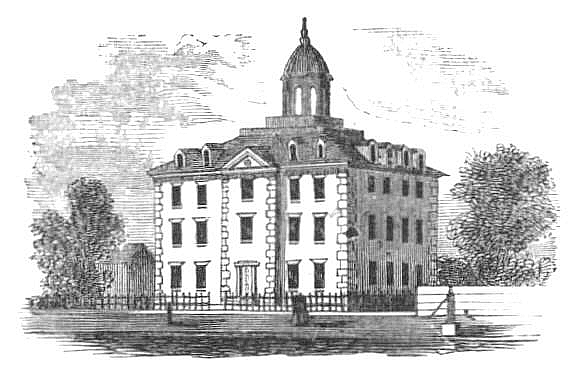
PROVOST JAIL. 5
The "New Jail" was made a provost prison, where American officers and the most eminent Whigs who fell into the hands of the British were confined. Here was the theatre of Cunningham’s brutal conduct toward the victims of his spite. The prisoners were formally introduced to him, and their name, age, size, and rank were recorded. They were then confined in the gloomy cells, or to the equally loathsome upper chamber, where the highest officials in captivity were so closely crowded together, that when, at night, they laid down to sleep upon the hard plank floor, they could change position only by all turning over at once, at the words right – left. Their food was scanty and of the poorest kind, often that which Cunningham had exchanged at a profit for better food received from their friends or the commissariat. Little delicacies brought by friends of the captives seldom reached them, and the brutal Cunningham would sometimes devour or destroy such offerings of affection, in the presence of his victims, to gratify his cruel propensities. Thus for many months gentlemen of fortune and education, who had lived in the enjoyment of the luxuries and refined pleasures of elegant social life, were doomed to a miserable existence, embittered by the coarse insults of an ignorant, drunken Irish master, or to a speedy death caused by such treatment, the want of good food, and fresh air, and innumerable other sufferings, the result, in a great measure, of the criminal indifference (it may be commands) of Loring, Sproat, and Lennox, commissaries of prisoners at various times. Still greater cruelties were practiced upon the less conspicuous prisoners, and many were hanged in the gloom of night, without trial or known cause for the foul murder. 6 And yet, in the presence of the known fact that British power administered by military despotism was the cause of these sufferings, that infamous time-server, Hugh Gaine, who six months previously was professedly a zealous patriot, dared to insult truth and common honesty by publishing in his papers [Nov. 25., 1776.] falsehoods like this: "There are now five thousand prisoners in town, many of them half naked. Congress, deserting the poor wretches, has sent them neither provisions nor clothing, nor paid attention to their distress, or that of their families. Their situation must have been doubly deplorable, but for the humanity of the king’s officers. Every possible attention has been given, considering their great numbers and necessary confinement, to alleviate their distress arising from guilt, sickness, and poverty."
The heart sickens at the recital of the sufferings of these patriots, and we turn in disgust from the view which the pen of faithful history reveals. Let us draw before it the vail of forgetfulness, and, while contemplating the cruelties and woes of that hour of the past, listen to the suggestions of Christian charity, which observes that much of the general suffering was the result of stern necessity, and that the cry of individual wrongs, inflicted by Cunningham and his hirelings, did not often reach the ears of the more humane officers of the British army.
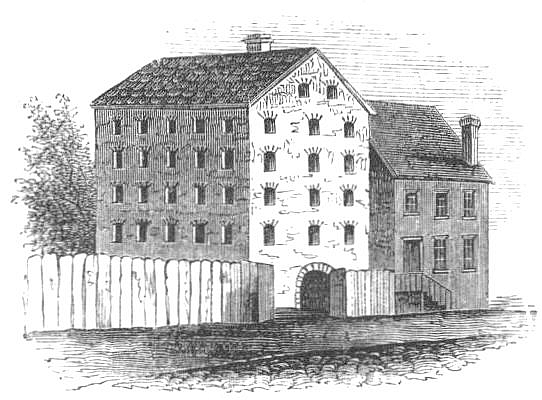
SUGAR-HOUSE IN LIBERTY STREET. 7
Next to the provost prison, the sugar-house in Liberty Street was most noted for the sufferings of captive patriots. It was a dark stone building, five stories in height, with small deep windows like port-holes, giving it the appearance of a prison. Each story was divided into two apartments. A large, barred door opened upon Liberty Street, and from another, on the southeast side, a stair-way led to gloomy cellars, which were used as dungeons. Around the whole building was a passage a few feet wide, and there, day and night, British and Hessian sentinels patroled. The whole was inclosed by a wooden fence nine feet in height. Within this gloomy jail the healthy and the sick, white and black, were indiscriminately thrust; and there, during the summer of 1777, many died from want of exercise, cleanliness, and fresh air. "In the suffocating heat of summer," says Dunlap, "I saw every aperture of those strong walls filled with human heads, face above face, seeking a portion of the external air." At length, in July, 1777, a jail fever was created, and great numbers died. During its prevalence the prisoners were marched out in companies of twenty, to breathe the fresh air for half an hour, while those within divided themselves into parties of six each, and there alternately enjoyed the privilege of standing ten minutes at the windows. They had no seats, and their beds of straw were filled with vermin. They might have exchanged this horrid tenement for the comfortable quarters of a British soldier by enlisting in the king’s service, but very few would thus yield their principles. They each preferred to be among the dozen bodies which were daily carried out in carts and cast into the ditches and morasses beyond the city limits. Sheds, stables, and other outhouses received hundreds of prisoners, who suffered terribly from cold and hunger during the winter succeeding their capture at Fort Washington. Few now live to recite their experience of this horrid sacrifice to the demon of discord, and humanity would gladly drop a tear upon this chapter of the dark record of man’s wrongs, and blot it out forever. Escapes, death, exchange of prisoners, and a more humane policy, gradually thinned the ranks of the sufferers in the city prisons, and when peace came, few were left therein to come out and join in the general jubilee. Hundreds had left their brief records upon the walls and beams (the initials of their names), which remained until these prisons were demolished. 8
------------------------------------------------------------------------
PRISON-SHIPS.
The sufferings of American captives in British hulks were greater even than those in the prisons on land. We have already alluded to the woes of those captured at Savannah and Charleston; we will now note briefly the condition of those at New York.
The prison-ships were intended for seamen taken on the ocean, yet some soldiers were confined in them. The first vessels used for the purpose were the transports in which cattle and other stores were brought by the British in 1776. These lay in Gravesend Bay, and there many of the prisoners taken in the battle near Brooklyn were confined until the British took possession of New York, when they were removed to prisons in the city, and the transports were anchored in the Hudson and East Rivers. In 1778 the hulks of decaying ships were moored in the Wallabout or Wallebocht, a sheltered bay on the Long Island shore, where the present Navy Yard is. There, in succession, the Whitby, Good Hope, Scorpion, Prince of Wales, Falmouth, Hunter, Stromboli, and half a dozen of less note were moored, and contained hundreds of American seamen captured on the high seas. 9 The sufferings of these captives were intense, and at the close of 1779 they set fire to two of them, hoping to secure either liberty or death. They felt it
"Better
the greedy wave should swallow all,
Better to meet the death-conducting ball,
Better to sleep on ocean’s oozy bed,
At once destroyed and numbered with the dead,
Than thus to perish in the face of day,
Where twice ten thousand deaths one death delay.
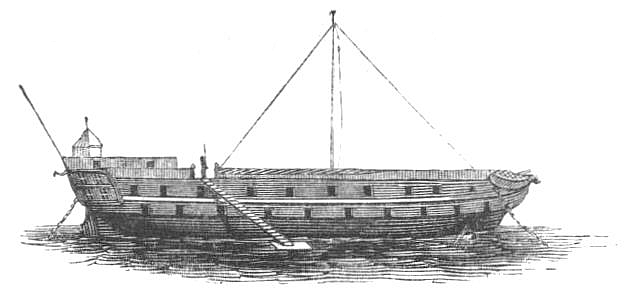
THE JERSEY PRISON-SHIP. 10
In 1780, the Jersey, originally a sixty-four gun ship (but, because unfit for service, was dismantled in 1776), was placed in the Wallabout, and used as a prison-ship till the close of the war, when she was left to decay on the spot where her victims had suffered. Her companions were the Stromboli, Hunter, and Scorpion, then used as hospitals. The latter was moored in the Hudson, toward Paulus’s Hook. The large number confined in the Jersey, sometimes more than a thousand at a time, and the terrible sufferings which occurred there, have made her name pre-eminent, and her history a synonym for prison-ships during the war. Her crew consisted of a captain, two mates, cook, steward, and a dozen sailors. She had also a guard of twelve old invalid marines, and about thirty soldiers, drafted from British and Hessian corps lying on Long Island. These were the jailers of the American captives, and were the instruments of great cruelty. Unwholesome food, foul air, filth, and despondency soon produced diseases of the most malignant nature. Dysentery, small-pox, and prison fever were the most prevalent, and, for want of good nurses and medical attendants, they died by scores on the Jersey and the hospital ships. The voice of human sympathy seldom reached the ears of the captives, and despair was the hand-maid of contagion. No systematic efforts for their relief were made, and, because of the contagious character of the diseases, no person ever visited the hulks to bestow a cheering smile or a word of consolation. 11 All was funeral gloom, and hope never whispered its cheering promises there. When the crews of privateers were no longer considered prisoners of war by the British (see page 644 {original text has "850".}), the number of captives in confinement fearfully increased, and Congress had no adequate equivalents to exchange. Policy, always heartless, forbade the exchange of healthy British prisoners for emaciated Americans, and month after month the hapless captives suffered, and then died.
The name and character of each prisoner were registered when he first came on board. He was then placed in the hold, frequently with a thousand others, a large portion of them covered with filthy rags, often swarming with vermin. In messes of six they received their daily food every morning, which generally consisted of moldy biscuit filled with worms, damaged peas, condemned beef and pork, sour flour and meal, rancid butter, sometimes a little filthy suet, but never any vegetables, Their meat was boiled in a large copper kettle. Those who had a little money, and managed to avoid robbery by the British underlings, sometimes purchased bread, sugar, and other niceties, which an old woman used to bring alongside the hulk in a little boat. 12 Every morning the prisoners brought up their bedding to be aired, and, after washing the decks, they were allowed to remain above till sunset, when they were ordered below with imprecations, and the savage cry, "Down, rebels, down!" The hatches were then closed, and in serried ranks they lay down to sleep, if possible, in the putrid air and stifling heat, amid the sighs of the acutely distressed and the groans of the dying. Each morning the harsh order came below, "Rebels, turn out your dead!" The dead were selected from the living, each sewed in his blanket, if he had one, and thus conveyed in a boat to the shore by his companions under a guard, and hastily buried.
"By
feeble hands their shallow graves were made;
No stone-memorial o’er their corpses laid.
In barren sands, and far from home, they lie,
No friend to shed a tear when passing by."
Several times successful attempts at escape were made, and these drew the cords of captivity closer, until the name of "Hell" for the Jersey was a proper synonym. Various minute accounts of the sufferings of the prisoners have been published, the substance of which, with other interesting matter concerning the prisons and prison-ships at New York, may be found in Onderdonk’s Revolutionary Incidents, ii., 207-250 inclusive.
So shallow were the graves of the dead on the shores of the Wallabout, that while the ships were yet sending forth their victims, the action of the waves and the drifting of the loose sand often exposed the bones of those previously buried. Year after year this revolting exhibition might be seen, and yet no steps were taken to preserve the remains of the martyred patriots, until 1803 [Feb. 10, 1803.], when Samuel L. Mitchill presented a memorial to Congress, in behalf of the Tammany society of New York, soliciting a tomb for the Martyrs. This petition caused propositions for the erection of a great number of monuments, ordered by the Continental Congress to be reared in memory of various revolutionary worthies. The prayer of the petitioners was not granted, and no further legislative action was had. The Tammany Society resumed the consideration of the subject in the winter of 1807, appointed a committee, and on the thirteenth of April, 1808, the cornerstone of a vault for the remains was laid, with imposing ceremonies upon land presented for the purpose by John Jackson, Esq., situated on the southwestern verge of the Navy Yard, near the termination of Front Street, at Hudson Avenue, Brooklyn. Joseph D. Fay, Esq., delivered an eloquent address on the occasion. On the twenty-sixth of May, 1808, a grand funeral procession, formed of societies and citizens of New York and Brooklyn, marched to the finished vault, and there, in the presence of at least fifteen thousand persons, thirteen coffins, filled with remains taken from the shore of the Wallabout, were placed in it. 13 Doctor Benjamin Dewitt delivered a pathetic funeral oration to the vast crowd, "while tears of sympathy bedimmed their eyes."
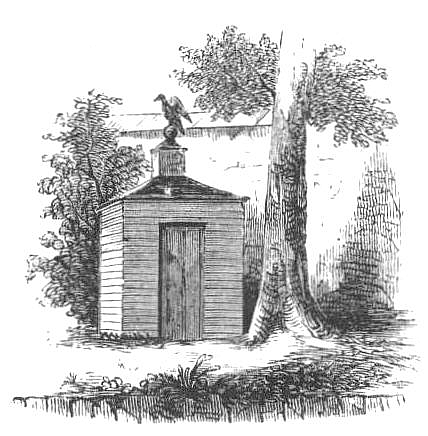
THE ANTE-CHAMBER. 14
A small wooden building was erected over the vault, as an ante-chamber, intended to be temporary. In front of it was placed a wooden fence, with thirteen posts, and upon the bars were painted the names of the original thirteen states. The ante-chamber yet (1852) remains, and some of the posts are yet there, but the original design has never been accomplished. Forty-four years have elapsed, and yet no enduring monument has been raised to the memory of those martyrs for freedom. Efforts toward that end are now in progress. A committee has been appointed in Brooklyn, and it is to be hoped that a worthy memorial will be speedily reared upon the spot.
------------------------------
ENDNOTES
1 I have had frequent occasion to quote for epigraphs, appropriate sentences from the terse rhymes of Freneau. He was a staunch Whig, and his satires, aimed at the opponents of the Revolution, were very popular. He was for sometime a captor in the Scorpion prison-ship, moored in the Hudson, at New York, and has left a vivid poetic record of the sufferings of himself and fellow-captives. He was warm supporter of Mr. Jefferson, and was for many years an industrious political writer in favor of the Democratic party. Mr. Freneau’s remains are in his family burial ground at Freehold, New Jersey, where the body of his venerable widow was placed at her death, occurred in 1849.

I am indebted to Dr. J. W. Francis for the original of the signature given above.
3 The mahogany pulpit was carefully removed, sent to London, and placed in a chapel there.
4 The church was not repaired until 1795, when it was re-dedicated to Christian worship, by Reverend John Livingston, D. D., as chief officiating clergyman. The bell which formerly hung in the tower is now in a church in Ninth Street, New York, where it may he heard every Sabbath.
5 This was a small stone building, nearly square in form, and three stories in height, erected in "the fields" in 1758. Its old walls now form a part of the Hall of Records. The main entrance to the prison was on the south. It had two lobbies, with strong barricades between the external and internal ones. On the right of the entrance was the room occupied by Cunningham, and opposite was that of Sergeant O’Keefe, his deputy in office and cruelty. A grated door was at the bottom of the stairs leading to the second and third floors. The northwest chamber on the second floor was devoted to officers and civilians of highest rank, and was called, in derision, Congress Hall. The late venerable John Pintard related the following anecdote of O’Keefe: As the Americans were moving down Clinton to Pearl Street, on the day of the British evacuation, O’Keefe thought it time for him to depart. A few British subjects, convicted of various crimes, were yet in his custody. As he was leaving, one of them inquired, "Sergeant, what is to become of us?" "You may all go to the devil," he replied, in anger, as he threw the keys upon the floor behind him. "Thank you, sergeant," was the answer; "we have had too much of your company in this world to follow you to the next."
6 During the whole time of the occupation of the city by the British, a gallows stood upon the brow of a hill, near the site of Burton’s Theater, in Chambers Street. It was called Gallows Hill, and overlooked the Fresh Water Pond, and the little island near the junction of Center and Pearl Streets, whereon for many years a powder-house stood. From this circumstance, that portion of Pearl Street was long called Magazine Street. The execution of American prisoners generally took place soon after midnight. The victims were accompanied to the gallows by Cunningham and his deputy, with a guard of eight men, and mercilessly murdered by the cord. When flesh and blood were wanting, effigies were often suspended upon that gibbet; and for a long time a tolerably correct portrait of John Hancock might be seen dangling from the cross-beam.
7 This is from a sketch by Mr. William J. Davis, of New York, to whose courtesy I am indebted for a knowledge of many interesting relics of the "olden time" in the city.
8 When the Liberty Street Sugar-house was taken down, some of its timbers were converted into canes and other objects, by persons of antiquarian taste. Among these was Mr. David Barker, a merchant of New York, who possessed a cane made of the wood. Toward the close of 1851, he communicated, through a city paper, his desire to present the cane to a survivor of the sugar-house prisoners, if one was living. Several claimed the prize, all of whom were undoubtedly prisoners there. In determining the award by lot, the precious relic fell to Levi Hanford, of Walton, Delaware county, New York, who lived until Novem. 19th, 1854, in the enjoyment of fair health and vigor. He was confined in the sugar-house for seventeen months.
9 The venerable Jeremiah Johnson, ex-mayor of Brooklyn, who died in, October, 1852, deposited in the Naval Lyceum a very valuable plan of the Wallabout as it was in the Revolution, showing the position of the several prison-ships, the houses upon the shore, burial-place of the victims, &c.
10 This is from a sketch in Recollections of the Jersey Prison-ship, prepared from the manuscript of Thomas Dring, a prisoner, by Albert G. Greene, Esq., of Providence, Rhode Island. The tent seen upon the quarter-deck near the stern, was used by the guard for a covering during hot weather. A flag-staff for signals was in the center. On the quarter-deck was a barricade, ten feet in height, with a door and loop-holes on each side. The officers’ cabin and the steerage for the sailors were under the quarter-deck.
11 Philip Freneau related a remarkable fact to his friend, Dr. Francis. He says that while Northern and Southern men, used to different climates, were crowded together during the rage of the pestilence, many of whom had never been inoculated for small-pox, at least sixty or seventy of them, now for the first time exposed to the disease, escaped its effects.
12 This was a corpulent old woman known as "Dame Grant." She visited the ship every alternate day. Her boat was rowed by two boys, who delivered what she brought in parcels, with the price affixed. She at length became a victim to the diseases of the hulk, and her death was a great loss to the captives.
13 The number of American prisoners buried at the Wallabout is not known. At the time of the interment in 1808, it was stated to be more than eleven thousand. Among the remains gathered and deposited in the vault at the Navy Yard, are doubtless many British and Hessian soldiers, known to have been buried there. Of course, no distinction could be made when the remains were collected. They probably form a very small part of the gathered relics of the martyrs.
14 This is a sketch of the ante-chamber, taken from Hudson Avenue. The building is eight feet square, and ten in height. Upon the cupola, surmounted by an eagle perched upon a globe, are long inscriptions, all irrelevant except the one upon the west aide, which contains a brief history of the interment.
----------------------------------------
Transcription and html prepared by Bill Carr, last updated 07/02/2001.
Please provide me with any feedback you may have concerning errors in the transcription or any supplementary information concerning the contents. wcarr1@nycap.rr.com
Copyright Notice: Copyright 2001. All files on this site are
copyrighted by their creator. They may be linked to but may not be
reproduced on another site without the specific permission of their
creator. Although public